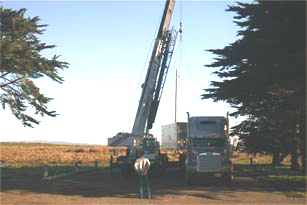From Coastal Clouds to Desert Dust: ARM Mobile Facility Headed to Africa
Published: 15 September 2005

After a successful six-month stint taking cloud and aerosol measurements at Point Reyes National Seashore on the California coast, ARM operations staff began packing up the ARM Mobile Facility (AMF) for its next destination: Niamey, Niger, in West Africa. Once there, it will be stationed beneath a geostationary satellite (Meteosat-8) above Niamey, the capital of Niger. Beginning in January 2006, the AMF will obtain comparative cloud and radiative property data as part of an international effort to study the effects of Saharan dust and the West African monsoons.
March 2005 marked the beginning of the AMF’s first field campaign, Marine Stratus Radiation Aerosol and Drizzle (MASRAD). Throughout the campaign, numerous guest instruments joined the fray to take advantage of the unique marine environment and infrastructure established for the AMF deployment. As expected (and hoped for), heavy marine clouds moved over the site in July and August. During the month of July, two research aircraft made almost daily flights over the site to collect cloud and aerosol measurements from above, within, and below the clouds. At the conclusion of the field campaign, the science team reported they were extremely happy with the data set collected. A preliminary look at the data showed aerosol counts ranging from low to high, indicating that even the pristine seashore location was heavily influenced by urban aerosols.
![The Niamey International Airport will be the site for the next ARM Mobile Facility (AMF) deployment set to begin in January 2006. The AMF will participate in a multi-national field campaign, known as the [http://amma.mediasfrance.org/][African Monsoon Multidisciplinary Analysis] (AMMA) project, to study the effects of Saharan dust and West African monsoons. Photo courtesy of Kim Nitschke.](/images/imported/plannedsiteinAfrica.jpg)
Niger, West Africa, is one of the hottest countries in the world with heat so intense that it often causes the rain to evaporate before it hits the ground. The anticipated heat and dust is of concern to everyone participating in the campaign. Operations staff are currently preparing delicate instruments for the extreme conditions to address these concerns. Niamey, a river port and trade center located on the Niger River in the southwestern region of the country, will be headquarters for the AMF. The one-year deployment will allow the science team to collect data during both the dry and wet (monsoon) seasons. The dry season, with poor visibility conditions from blowing Saharan dust, begins in November—just in time for the AMF to arrive!
The ARM Climate Research Facility is a DOE Office of Science user facility. The ARM Facility is operated by nine DOE national laboratories, including .
Keep up with the Atmospheric Observer
Updates on ARM news, events, and opportunities delivered to your inbox
ARM User Profile
ARM welcomes users from all institutions and nations. A free ARM user account is needed to access ARM data.


















